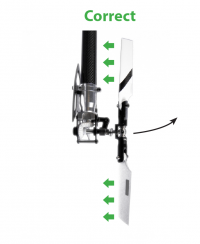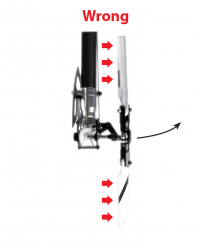Translations:Manuals:BXFbl:Setupmenu E/10/en: Difference between revisions
Importing a new version from external source |
Importing a new version from external source |
||
| Line 1: | Line 1: | ||
=Extra info: How the gyro works!= | =Extra info: How the gyro works!= | ||
The gyro always tries to steer in the opposite direction of the rotation that is applied to the helicopter. If you move the helicopter by hand around its vertical axis, the gyro must actuate a rudder servo movement to compensate this rotation. If for example you move the nose of the helicopter to the left (tail moving to the right), the gyro has to steer right the same way as you would steer right with the rudder stick, so that the tail is pushed back to the left. | The gyro always tries to steer in the opposite direction of the rotation that is applied to the helicopter. If you move the helicopter by hand around its vertical axis, the gyro must actuate a rudder servo movement to compensate this rotation. If for example you move the nose of the helicopter to the left (tail moving to the right), the gyro has to steer right the same way as you would steer right with the rudder stick, so that the tail is pushed back to the left.<br /> | ||
<br /> | <br /> | ||
<gallery widths="200" heights="250" style="font-size: 80%;"> | <gallery widths="200" heights="250" style="font-size: 80%;"> | ||
| Line 6: | Line 6: | ||
Image:Tailgyro_wrong.png|When moving the tail to the right by hand (nose of the heli to the left), the gyro steers to the left and so the tail will move even further! | Image:Tailgyro_wrong.png|When moving the tail to the right by hand (nose of the heli to the left), the gyro steers to the left and so the tail will move even further! | ||
</gallery> | </gallery> | ||
<br /> | |||
Please note: This only shows an example for the ALIGN T-Rex 500 helicopter. Actually the tail pitch slider may move to a different position on your helicopter. This mainly depends on how the tail blade grips are controlled and how the tail mechanics is constructed in general. Check the manual of your helicopter to find out which directions the rudder must move on your helicopter.<br /> | Please note: This only shows an example for the ALIGN T-Rex 500 helicopter. Actually the tail pitch slider may move to a different position on your helicopter. This mainly depends on how the tail blade grips are controlled and how the tail mechanics is constructed in general. Check the manual of your helicopter to find out which directions the rudder must move on your helicopter.<br /> | ||
<br /> | <br /> | ||
<br /> | <br /> | ||
Latest revision as of 14:30, 4 June 2024
Extra info: How the gyro works!
The gyro always tries to steer in the opposite direction of the rotation that is applied to the helicopter. If you move the helicopter by hand around its vertical axis, the gyro must actuate a rudder servo movement to compensate this rotation. If for example you move the nose of the helicopter to the left (tail moving to the right), the gyro has to steer right the same way as you would steer right with the rudder stick, so that the tail is pushed back to the left.
-
When moving the tail to the right by hand (nose of the heli to the left), the gyro will steer to the right, so the tail is pushed back to the left.
-
When moving the tail to the right by hand (nose of the heli to the left), the gyro steers to the left and so the tail will move even further!
Please note: This only shows an example for the ALIGN T-Rex 500 helicopter. Actually the tail pitch slider may move to a different position on your helicopter. This mainly depends on how the tail blade grips are controlled and how the tail mechanics is constructed in general. Check the manual of your helicopter to find out which directions the rudder must move on your helicopter.

